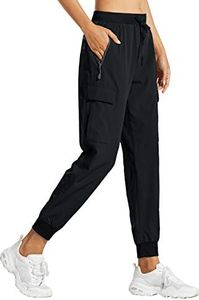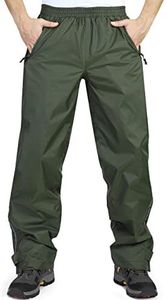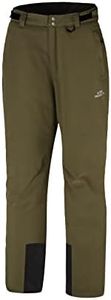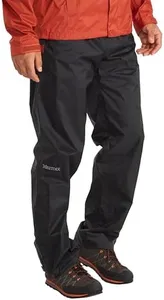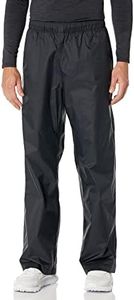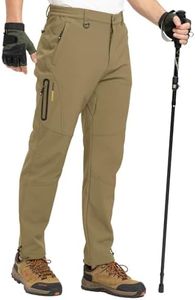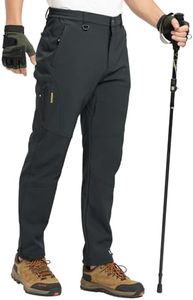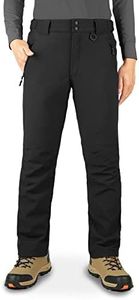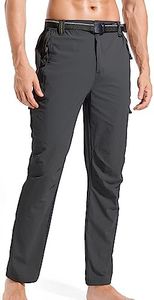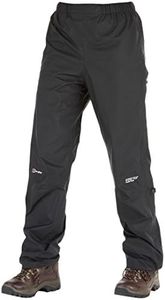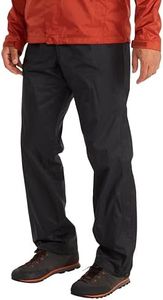We Use CookiesWe use cookies to enhance the security, performance,
functionality and for analytical and promotional activities. By continuing to browse this site you
are agreeing to our privacy policy
10 Best Waterproof Hiking Pants
From leading brands and best sellers available on the web.Buying Guide for the Best Waterproof Hiking Pants
When looking for waterproof hiking pants, your goal is to stay dry, comfortable, and mobile no matter the weather conditions or terrain. The right pair not only protects you from rain and wet vegetation but also allows your skin to breathe and lets you move freely during hikes. By understanding the important features and materials, you can choose the pants that fit your hiking environment and your comfort preferences.Waterproof RatingThe waterproof rating tells you how well the fabric of the pants can keep out water. It's usually measured in millimeters, indicating how much water pressure the material can handle before leaking. Lower ratings (up to 5,000mm) provide basic protection against light rain or damp conditions, while mid-range (5,000mm to 15,000mm) works for moderate to heavy rain. High ratings (15,000mm and above) offer excellent protection for prolonged heavy rain or very wet environments. If you mostly hike in light rain or misty areas, a lower rating might suffice, but for all-day trekking in unpredictable or wet climates, opt for at least a mid-range or higher rating.
BreathabilityBreathability refers to how well the pants allow moisture and sweat to escape from inside, keeping you dry and comfortable. It’s usually measured by the amount of water vapor that can pass through the fabric in a day. Low breathability might leave you feeling clammy, especially during strenuous hikes. Casual walkers in cool or wet areas may get away with lower breathability, but if you plan to be active or walk in varying climates, choose pants that are specifically described as breathable or featuring special ventilation systems, which help to regulate your body temperature.
Fabric TypeThe fabric of waterproof hiking pants affects durability, feel, and performance. Common materials include nylon, polyester, and various blends, often treated with waterproof coatings or containing special waterproof membranes. Lightweight fabrics are easy to pack and move in but might not hold up to frequent abrasion, while heavier and reinforced fabrics provide better durability but can be less flexible. Consider terrain and intended use: if you'll be bushwhacking or sitting on rough surfaces, durability is key; for fast-paced or long hikes, lighter fabrics offer more comfort.
Fit and MobilityFit and mobility describe how the pants are cut and how they move with your body. Some pants are more fitted, which can reduce bulk and chafing, while others have a looser, more relaxed cut for layering and freedom of movement. Features like articulated knees, gusseted crotches, and adjustable waistbands improve comfort and allow for easier walking, climbing, or crouching. Think about your hiking habits: if you want pants to slip over base layers or want freedom for dynamic movement, choose a relaxed fit with articulations; for short walks or mild terrain, a trimmer fit may feel better and reduce snagging.
Weight and PackabilityWeight and packability determine how easy it is to carry the pants when you’re not wearing them. Ultralight and packable designs are ideal for long trips or uncertain weather where you may not always need rain protection but want it handy. Heavier options typically offer more robust waterproofing and durability. For occasional rain showers or if you’re layering over other pants, lighter options are convenient; if you expect to wear them for long periods in challenging conditions, the added weight may be worth the extra protection.
Ventilation FeaturesVentilation features include zippers, mesh-lined openings, and adjustable cuffs that help control heat and moisture inside the pants. These features are especially important in waterproof pants since waterproofing can trap body heat and sweat. If you hike in warm or humid environments, or you tend to sweat a lot during activity, look for pants with zippered vents above the knees or in the thighs, as these help you stay cool without removing your pants. In colder climates, you might not need as much ventilation.
Adjustable Closures and FeaturesAdjustable features like drawstrings, Velcro, snap or zippered ankles, and removable belts help you tailor the pants to your body and hiking boots. Ankle zippers make it easier to put pants on over boots or adjust airflow, while waist adjustments ensure a comfortable, secure fit. Choose pants with adjustability that matches your hiking preferences and what you wear underneath—this ensures better comfort and easier layering.
